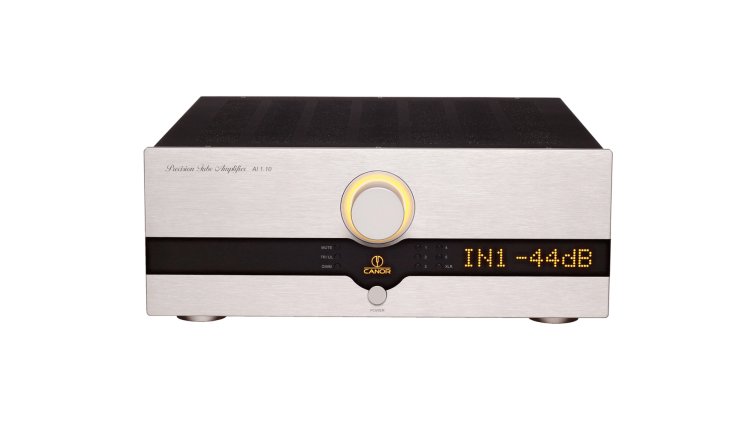Canor AI 1.10: it couldn't be better

You'll almost forget you're listening to a tube amp because it's so clean and neutral: Canor has produced a timeless classic amplifier that crosses genre barriers with the Canor AI 1.10.
So in pre-pandemic times, when no mask could hide the wide grin Karl-Heinz Fink's Finkteam system brought to the faces of nearly everyone who sat down on the seating furniture in the acoustically carefully designed demo room.
Canor's plant in Prešov, Slovakia, not only manufactures substantial portions of the Pro-Ject electronics but also serves other OEM clients. This makes effective use of the about 80 employees' capabilities and is undoubtedly responsible for the private label's deliberately tranquil market launch: we've rarely heard so little marketing arrogance from a company that is so plainly targeting the audiophile premium market. Obviously, no one is in a hurry or desires to immediately dominate a niche market for this or that product.
What was it about the 1.10 that made it so appealing? Aside from the superb quality that is delivered at the time, the notion of a truly ubiquitous, dependable tube integrated amplifier that can be adapted for nearly any speaker was intriguing.
It's a truly universal tube amp, with enough power but also low enough output resistance to drive actual boxes with generally complex load behavior in a dynamic and tonally balanced manner.

The AI 1.10 not only reached, but far exceeded, the test's ambitious goal: It obtains a sound from a set of regular tubes that you don't want to compare. A sound that is so completely self-contained that other amplifiers are no longer of relevance. You may make friends with the optics as well: The AI 1.10 appears to be as good as the other Canors.
The design is basic, and the execution is sophisticated, but not flashy or vulgar: the silver front panel has a certain thickness, which allows for a little recessed mounting of the center volume button, which appears to emerge from a soft amber glowing halo.
In honor of this, the continuous black acrylic band forms a festive arc, which bears the amber-colored lighted business emblem. To the right of this is a massive dot matrix display with a flawlessly matching color that can be seen from a long distance while also displaying the selected input and current volume with very little electrical interference.
If the amount of light bothers you, you can dim everything together in stages up to complete the blackout. The AI 1.10 then lights briefly to acknowledge commands from the front panel or remote control. All features, with the exception of triode ultra-linear switching, are accessible remotely and immediately on the device.
There are only three: volume, muting, and the selection of the five high-level inputs, all of which are handled by high-quality, permanently contact-safe relays.
Relays are also used to control the loudness. The display reads 0 dB when fully turned up. The passive preamp cannot boost the signal, but this is never necessary with normal-volume sources. It only becomes a problem with extremely awkward combinations: If you use an extra-quiet MC in the turntable, make sure the phono preamp has enough boost, for example.
Not only is the input selection technically performed, but so is the volume control, which is accomplished with high-quality, contact-safe relays: The relay signal box combines precisely the appropriate selection of precision resistors to a total of 64 one-decibel steps, depending on the desired weakening of the input signal.

Turning the play-free ball-bearing volume knob or pressing the corresponding buttons on the remote control results in not only a change in volume but also a lively click, revealing the technical luxury solution.
Their benefits include exact channel synchronization now as it was 20 years ago, the lowest possible distortion, and delightful side effects such as problem-free synchronization of numerous identical amps - we'll see what this is for in a moment.
A balancing control system would have been ideal and technically achievable. The accessible 1dB levels, on the other hand, would have been quite rough for this.
Following input selection and volume control, the active section of the amplifier – which is entirely tube-based: A double triode of type 12AX7 serves as the input stage, and two more double triodes — now of lower impedance but less power – act as the drivers.
Power amplification is handled via a pair of KT88 beam tetrodes per channel. It doesn't get much more common than this assortment of tubes - which is extremely fantastic news for a future exchange: these sorts are available in high quality from all around the world.
Canor's ability to make the AI 1.10 sound so open and unbiased is worthy of contemplation. Is it a house-wound noble transformer with a properly balanced core composition (30% permalloy)?
Circuit boards (CMT, Canor Milling Technology) artistically skeletonized by CNC milling, ostensibly combining the benefits of circuit boards and free wiring? Or is it simply a combination of years of experience, smart circuit design, and a dash of luck?
In any case, we don't know of anything better, finer, or less difficult for the price of this amp. The crucial specifications - KT88, 40 watts - are significantly less expensive. However, they do not reveal the entire tale. There isn't even a chapter of it.





























